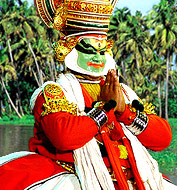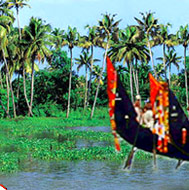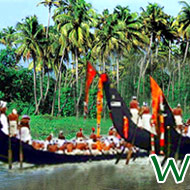Built by the Portuguese in 1557, Mattancherry Palace was presented to Raja Veera Kerala Varma of Kochi. The Dutch carried out a few renovation work and extension of the structure of the palace in 1663. Since then, the palace is popularly known as the Dutch Palace. Following the Dutch, a few rajas, residing at the palace, also made improvements, supplementing it with the unique tints from various cultures, thereby giving it a colorful yet organized look. Today, the palace boasts of having the largest number of paintings of Kochi Rajas. The palace is also famous for some noteworthy and artistic mythological murals in India which cover more than 300 ft of the palace walls. The themes of these murals have been borrowed from the great Indian epics - the Ramayana and the Mahabharatha, and mythology and legends about Hindu gods, especially Guruvayurappan.
Some murals depict scenes from Kumarasambhavam and other works of the great Sanskrit poet, Kalidasa. The palace, along with a Bhagavathi temple in the central courtyard, is built akin to the typical Kerala style mansion, the Nalukettu - the home of the nobility, aristocracy and upper classes, with four separate wings opening out to a central courtyard. Two different temples are situated on either sides of the palace, dedicated to Lord Krishna and Lord Siva. From the outside, the palace looks European in character with scraped masonry walls and round-headed windows and doors, but its sloping tiled roof and wooden balconies are indigenous features. The interiors, like the dining hall, have carved wooden ornate ceiling which is decorated with a series of brass cups. Further, the floor is an example of traditional Kerala flooring, giving the feel of a polished black marble, but is actually a mixture of burnt coconut shells, charcoal, lime, plant juices, and egg whites.
Apart from murals and the architecture, the palace houses some intricate artifacts and ancient woodcrafts, which are extremely rare and precious. Among other relics and exhibits is an ivory palanquin, a Howdah, royal umbrellas, weapons, swings, stamps, royal attires, coins etc. In 1951, the palace was restored and declared a centrally protected monument. Currently, it is under the second phase of restoration to keep its grandeur intact. The palace is in itself an architectural masterpiece which showcases a perfect blend of contemporary royalty and traditional Kerala architecture. The Mattancherry Palace can be reached through bus and boat services. You can hop in a boat from the Boat Jetty near Suhash Park at Ernakulam. The closest railway station is at Ernakulam, about 10 km, while the nearest airdrome is Cochin International Airport, at a distance of 20 km from Ernakulam town.
The Mattancherry palace, also called the Dutch
palace, ia an important monument of Kerala.
Holidays in Kerala : Kerala Monuments : Mattancherry Palace












